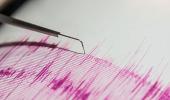Nepal's authorities on Sunday scrambled to rush aid to those affected by Friday's earthquake that has killed at least 157 people and left a trail of destruction in the Himalayan nation's remote mountainous region.

The earthquake with an epicentre in Jajarkot district, about 500km west of Kathmandu, was recorded just before midnight on Friday.
As the earthquake destroyed hundreds of houses in the mountainous region, several people had to spend Saturday night under the open sky.
Out of a total of 157 people who died in the tragedy, the bodies of 120 have so far been handed over to the family members. About 253 people were injured in the quake, the most devastating in the country since 2015.
The relatives of victims were now preparing for their cremations.
Prime Minister Pushpa Kamal Dahal 'Prachanda' on Sunday held a Cabinet meeting during which he decided to provide Rs. 2 lakh cash each to the family of those killed in the Jajarkot earthquake as immediate relief, according to officials.
The Nepal government also decided to provide free medical treatment to those injured in the earthquake.
"All the injured individuals will receive treatment free of cost, whatever may the cost be," Minister for Health and Population Mohan Bahadur Basnet said after the Cabinet meeting.
According to the minister, the rescue efforts for earthquake victims have been completed. But rescuers are still looking for people who could be trapped in the rubble of collapsed buildings.
“The distribution of food, tarps, and tents has already begun in some affected areas, with plans for further deliveries in progress. The government is committed to ensuring that all necessary assistance is provided to the survivors,” he said.
This time, the government will rectify the weaknesses that occurred during the 2015 earthquake response, he pointed out.
In the aftermath of the disaster, Nepal's immediate neighbours, India and China, and the United States have offered support with logistics, and search for the victims by sending rescue teams to the country.
Since various countries have expressed willingness to extend assistance to the earthquake victims, the government will formulate standards for the type of aid it can accept, he said.
Local government officials say the situation was chaotic on Saturday morning due to inadequate means to deal with the disaster.
Harischandra Sharma, assistant chief district officer in Jajarkot, said the under-resourced and poorly equipped district hospital was struggling.
“The hospital lacks both human resources and equipment to deal with a huge number of victims. We were struggling to cope with things on Saturday morning,” he told the Kathmandu Post newspaper.
The situation has largely come under control with more doctors and medical teams arriving from Kathmandu and Surkhet, he said.
“The people have been compelled to live in the cold under the open sky after they lost their houses to the disaster. Supporting them with relief materials should be our major focus. We are working to this effect,” Sharma said.
Suresh Sunar, the chief district officer of Jajarkot, said that rescue efforts had been ongoing since Friday night, but they were successfully concluded by Saturday night, allowing relief distribution to begin on Sunday.
Sunar also said that over 1,000 households have been affected, resulting in millions worth of damage.
He added that preparations have been made to streamline the relief distribution process through a one-door system. Jajarkot suffered the most damage in the earthquake that occurred on Friday night, with 105 casualties reported in Jajarkot alone.
A team of seismological experts at National Earthquake Monitoring and Research Center, Lainchaur has reached Jajarkot to carry out further study and research on the earthquake that occurred on Friday night.











 © 2025
© 2025